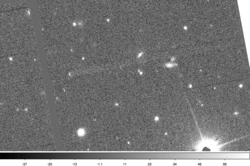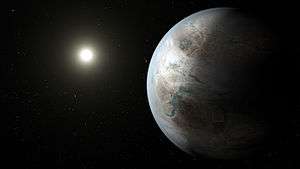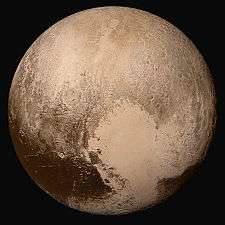2015 TB145
|
Discovery image of 2015 TB145 from the Pan-STARRS1 telescope, operated by the Institute for Astronomy at the University of Hawaii | |
| Discovery[1] | |
|---|---|
| Discovered by | Pan-STARRS (F51) |
| Discovery date | 10 October 2015 |
| Designations | |
| MPC designation | 2015 TB145 |
Apollo  NEO, PHA, Mercury-crosser asteroid, Venus-crosser asteroid, Mars-crosser asteroid[2] | |
| Orbital characteristics[2] | |
| Epoch 13 January 2016 (JD 2457400.5) | |
| Uncertainty parameter 2 | |
| Observation arc | 22 days |
| Aphelion | 3.9076 AU (584.57 Gm) (Q) |
| Perihelion | 0.29345 AU (43.899 Gm) (q) |
| 2.1005 AU (314.23 Gm) (a) | |
| Eccentricity | 0.86030 (e) |
| 3.04 yr (1112.0 d) | |
| 10.4818° (M) | |
| 0° 19m 25.5s / day (n) | |
| Inclination | 39.6863° (i) |
| 37.7318° (Ω) | |
| 121.731° (ω) | |
| Earth MOID | 0.00155156 AU (232,110 km) |
| Jupiter MOID | 2.41379 AU (361.098 Gm) |
| Jupiter Tisserand parameter | 2.964 |
| Physical characteristics | |
| Dimensions | 600 m (2,000 ft)[3][4] |
| 5 hours,[4] 2.938 h (0.1224 d)[2] | |
| 0.06[4] | |
| 20.0[2][5] | |
|
| |
2015 TB145 (also written 2015 TB145) is an Apollo near-Earth asteroid roughly 600 meters (2,000 feet) in diameter. It safely passed 1.27 lunar distances from Earth on 31 October 2015 at 17:01 UTC.[6]
The asteroid was first observed on 10 October 2015 by Pan-STARRS at an apparent magnitude of 20 using a 1.8-meter (71 in) Ritchey–Chrétien telescope.[1][5][lower-alpha 1] The asteroid was not discovered sooner because it spends most of its time beyond the orbit of Mars, has a large orbital inclination, and spends most of its time well below the plane of the ecliptic.[8] The asteroid last passed within 0.064 AU (9,600,000 km; 5,900,000 mi) of Earth on 29 October 1923 and will not pass that close again until 1 November 2088.[6] The 2015 flyby was its closest approach to Earth in at least the next 500 years.
The media has nicknamed the asteroid the "Great Pumpkin"[9] after the animated Halloween television special It's the Great Pumpkin, Charlie Brown,[10] "Spooky",[11][12] the “Halloween Asteroid”,[13][14][15] and the “Skull Asteroid”[10] due to its human skull-like appearance following radio frequency images taken at Arecibo Observatory.[10]
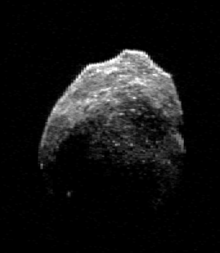
2015 flyby
On 31 October 2015 the asteroid passed 0.00191 AU (286,000 km; 178,000 mi) from the Moon and then passed 0.00325 AU (486,000 km; 302,000 mi) from Earth.[6]
The last approach this close by an object (with absolute magnitude < 20) was 2004 XP14 on 3 July 2006 at 1.1 lunar distances. The next object this large known to pass this close to Earth is (137108) 1999 AN10 that will pass about 1 lunar distance from Earth on 7 August 2027.[16] It is estimated that there are about 2400 near-Earth asteroids 300–500 meters in diameter, of which about 1100 have been discovered.[17]
During closest approach to Earth the asteroid reached about apparent magnitude 10,[18] which is much too faint to be seen by the naked eye. Even at peak brightness, the asteroid was a challenging target for amateur astronomers with small telescopes, best seen in the Northern hemisphere. The glare from an 80% waning gibbous Moon also hindered observations.
At 11:00 UT the asteroid was in the constellation of Taurus about 9 degrees from the Moon and moving at a rate of 3.4 degrees per hour.[18] At the time of closest approach of 17:00 UT the asteroid was in the constellation of Ursa Major about 56 degrees from the Moon and moving at a rate of 14.7 degrees per hour.[18] After closest approach it quickly became too faint and too close to the Sun in the sky to be seen.[16]
|
Animation of flyby
|
Radar imagery
The close approach was studied with radar using Goldstone, the Green Bank Telescope,[16] and the Arecibo Observatory. It was one of the best radar targets of the year with a resolution as high as 2 meters (7 ft) per pixel.[16] Bistatic radar images created with the Green Bank Telescope had a resolution of 4 meters (13 ft) per pixel.[19] Arecibo images had a resolution of 7.5 meters (25 ft) per pixel.[4]
| October 30 | October 31 12:55 - 13:08 UTC |
November 1 |
|---|---|---|
 |
 |
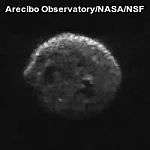 |
Possible cometary origin
The high orbital inclination and eccentricity suggest 2015 TB145 may be an extinct comet that has shed its volatiles after numerous passes around the Sun.[4][20] Orbital calculations by Petrus Jenniskens and Jérémie Vaubaillon show that it is not expected to produce associated meteors in 2015.[21] Meteoroids should pass more than 0.0007 AU (100,000 km; 65,000 mi) from Earth's orbit.[21] If meteoroids do cross Earth's path, the radiant should be Northern Eridanus.[21] Cameras for Allsky Meteor Surveillance (CAMS) did not detect any activity in the presumed area of the sky during 2013 and 2014.[21] The object has a low albedo of 0.06, which is only slightly more than a typical comet that has an albedo of 0.03-0.05.[4]
Notes
- ↑ For comparison, around 6 October 2012 the asteroid peaked at about apparent magnitude 20.9, but had a solar elongation of only about 75 degrees while 0.4AU from Earth.[7]
References
- 1 2 "MPEC 2015-T86 : 2015 TB145". IAU Minor Planet Center. 2015-10-13. Retrieved 2015-10-14. (K15TE5B)
- 1 2 3 4 "JPL Small-Body Database Browser: (2015 TB145)" (last observation: 2015-10-27; arc: 17 days). Jet Propulsion Laboratory. Retrieved 4 April 2016.
- ↑ "Absolute Magnitude (H)". NASA/JPL. Retrieved 2015-10-14.
- 1 2 3 4 5 6 Halloween Skies to Include Dead Comet Flyby. NASA-JPL press release. October 30, 2015
- 1 2 "2015 TB145 Orbit". IAU Minor Planet Center. Retrieved 2016-01-24.
- 1 2 3 "JPL Close-Approach Data: (2015 TB145)" (last observation: 2015-10-27; arc: 17 days). Retrieved 2015-10-22.
- ↑ "2015TB145 Ephemerides for October 2012". NEODyS (Near Earth Objects – Dynamic Site). Retrieved 2015-10-24.
- ↑ Kelly Beatty (2015-10-22). "Close-in Asteroid Offers Halloween Treat". Sky & Telescope. Retrieved 2015-10-26.
- ↑ Sarah Begley (30 October 2015). "NASA Says 'Great Pumpkin' Asteroid Will Fly by on Halloween". TIME Magazine.
- 1 2 3 Nick Divito (31 October 2015). "Spooky 'skull asteroid' whizzes past Earth on Halloween". New York Post.
- ↑ Andrew Fazekas (23 October 2015). "Asteroid Called 'Spooky' Will Buzz Earth on Halloween". National Geographic Society.
- ↑ RT (31 October 2015). "'Spooky' asteroid to fly by Earth on Halloween". RT (Russia Today).
- ↑ Charles Poladian (20 October 2015). "Halloween Asteroid 2015 TB145 Hurtling Toward Earth At 80,000 MPH: Doomsday Threat?". International Business Times.
- ↑ Morina Koren (31 October 2015). "A Halloween Comet". The Atlantic.
- ↑ ESA (28 October 2015). "Halloween Asteroid Gives us a Miss, Confirms ESA". European Space Agency.
- 1 2 3 4 Dr. Lance A. M. Benner (24 October 2015). "Goldstone Radar Observations Planning: 2009 FD and 2015 TB145". NASA/JPL Asteroid Radar Research. Retrieved 2015-10-24.
- ↑ "WISE Revises Numbers of Asteroids Near Earth". NASA/JPL. 2011-09-29. Retrieved 2015-10-29. (NASA Space Telescope Finds Fewer Asteroids Near Earth)
- 1 2 3 "2015TB145 Ephemerides for 15 October 2015 through 31 October 2015". NEODyS (Near Earth Objects – Dynamic Site). Retrieved 2015-10-14.
- ↑ "PIA20043: Halloween Asteroid Rotation". NASA/JPL-Caltech/GSSR/NRAO/GB. 2015-11-03. Retrieved 2015-11-04.
- ↑ Agle, D. C. (21 October 2015). "NASA Spots the 'Great Pumpkin': Halloween Asteroid a Treat for Radar Astronomers". NASA News. Retrieved 2015-10-26.
- 1 2 3 4 "Possible October 31 Meteors From Minor Planet 2015 TB_145". SETI Institute. 2015-10-26. Retrieved 2015-10-26. (CBET 4154)
External links
| Wikimedia Commons has media related to 2015 TB145. |
- Orbital simulation from JPL (Java) / Ephemeris
- ALERT! Bright NEO 2015 TB145 on 29-31 October, 2015 – Ian Musgrave (itelescope)
- WebCite archive of JPL solution #2 from 2015-Oct-14
- Halloween Asteroid is a Radar Science Treat (NASA Jet Propulsion Laboratory on YouTube)
- Halloween Asteroid 2015 TB145 Flyby Jerry Hilburn, 10/31/2015 12:12-12:24AM, Catfish Observatory, Teirra Del Sol, Canon 5D and an Orion ED 80 Refractor on an AVX Celestron Mount
- 2015 TB145 at the JPL Small-Body Database

